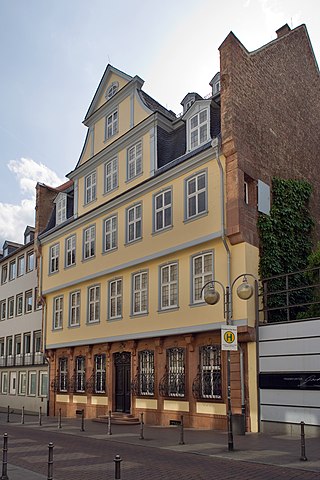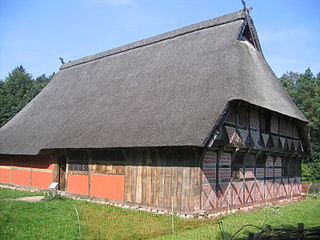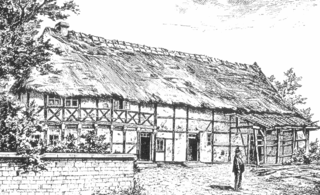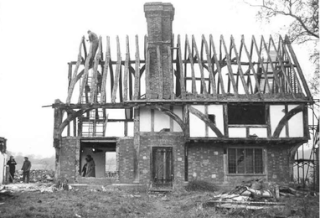
A barn is an agricultural building usually on farms and used for various purposes. In North America, a barn refers to structures that house livestock, including cattle and horses, as well as equipment and fodder, and often grain. As a result, the term barn is often qualified e.g. tobacco barn, dairy barn, cow house, sheep barn, potato barn. In the British Isles, the term barn is restricted mainly to storage structures for unthreshed cereals and fodder, the terms byre or shippon being applied to cow shelters, whereas horses are kept in buildings known as stables. In mainland Europe, however, barns were often part of integrated structures known as byre-dwellings. In addition, barns may be used for equipment storage, as a covered workplace, and for activities such as threshing.

Boscobel House is a Grade II* listed building in the parish of Boscobel in Shropshire. It has been, at various times, a farmhouse, a hunting lodge, and a holiday home; but it is most famous for its role in the escape of Charles II after the Battle of Worcester in 1651. Today it is managed by English Heritage.

The Goethe House is a writer's house museum located in the Innenstadt district of Frankfurt, Germany. It is the birthplace and childhood home of German poet and playwright Johann Wolfgang von Goethe. It is also the place where Goethe wrote his famous works Götz von Berlichingen,The Sorrows of Young Werther, and the first drafts of Urfaust. The house has mostly been operated as a museum since its 1863 purchase by the Freies Deutsches Hochstift, displaying period furniture and paintings from Goethe's time in the house.

The Spencer–Peirce–Little Farm is a Colonial American farm located at 5 Little's Lane, Newbury, Massachusetts, United States, in the midst of 231 acres (93 ha) of open land bordering the Merrimack River and Plum Island Sound. The farmhouse, dating to c. 1690, was designated a National Historic Landmark in 1968 as an extremely rare 17th-century stone house in New England. It is now a nonprofit museum owned and operated by Historic New England and open to the public several days a week during the warmer months; an admission fee is charged for non Members.

The Weald and Downland Living Museum is an open-air museum in Singleton, West Sussex. The museum is a registered charity.

The Low German house or Fachhallenhaus is a type of timber-framed farmhouse found in northern Germany and the easternmost Netherlands, which combines living quarters, byre and barn under one roof. It is built as a large hall with bays on the sides for livestock and storage and with the living accommodation at one end.

Rygnestadtunet is an open-air museum at Nordigard farm in northern Rygnestad in the municipality of Valle in Agder county, Norway. It is located in the Setesdal region of Norway, near the junction of the Norwegian National Road 9 and Norwegian County Road 45, about 9 kilometres (5.6 mi) north of the village of Valle. The farm museum today looks exactly as it did when it was deserted in 1919. The farm was legally protected in 1923, it was purchased by the Setesdal Museum in 1938, and it was opened to the public as a museum in 1940. Excavations in the area indicate that the site has been populated since at least 900 AD.

Kent Life is an English open-air museum located at Sandling near Maidstone, next to Allington Locks on the east bank of the River Medway.
A Treppenspeicher is the German term for a granary or secondary farm building used for storage and typical of the Lüneburg Heath area in northern Germany. The upper storey of the store was usually accessed via a flight of steps on the outside of the building, usually at one of the gable ends, thus giving the building its name.

Bleckmar is a village administered by the Lower Saxon town of Bergen in the northern part of Celle district on the Lüneburg Heath in North Germany. It lies about 3 kilometres (1.9 mi) north of Bergen on the B 3 federal road and has 464 inhabitants (2019). It is administratively responsible for the neighbouring hamlet of Dageförde.

The Hösseringen Museum Village is located at Hösseringen in the German state of Lower Saxony. Covering an area of 10,000 square metres, it displays important examples of the Lower German, timber-framed, open-hall house, the so-called Low German house or Fachhallenhaus.

The Winsen Museum Farm is an open-air museum in Winsen (Aller) in the north German state of Lower Saxony. It was started in 1982 and comprises a typical farmyard from the southern Lüneburg Heath around which other buildings, characteristic of the region, are grouped.

The Middle German house is a style of traditional German farmhouse which is predominantly found in Central Germany.

The Wealden hall house is a type of vernacular medieval timber-framed hall house traditional in the south east of England. Typically built for a yeoman, it is most common in Kent and the east of Sussex but has also been built elsewhere. Kent has one of the highest concentrations of such surviving medieval timber-framed buildings in Europe.
The Cloppenburg Museum Village and Lower Saxon Open-Air Museum located in the Lower Saxon county town of Cloppenburg is the oldest museum village in Germany. The museum is a research and educational establishment specializing in cultural and rural history.

A housebarn is a building that is a combination of a house and a barn under the same roof. Most types of housebarn also have room for livestock quarters. If the living quarters are only combined with a byre, whereas the cereals are stored outside the main building, the house is called a byre-dwelling.

Log buildings and structures can be categorized as historic and modern. A diverse selection of their forms and styles with examples of architectural elements is discussed in the following articles:
Beckedorf is a village and Ortschaft in the municipality of Südheide in northern Celle district in the German state of Lower Saxony. Situated on the western edge of the Southern Heath Nature Park in the Lüneburg Heath, about 1 km southwest of Hermannsburg itself, it currently has about 610 inhabitants. The name means "village on the Beke". In old records it can be found as Beketorpe, Bekendorpe or Beckedorp. In 1973 Beckedorf was incorporated into the parish of Hermannsburg as part of Lower Saxony's territorial and administrative reforms.

The Lorraine house or Lorraine farmhouse is a vernacular, agricultural house type found in Lorraine in France and the western part of the Saarland in Germany. It is a byre-dwelling, with the living and working quarters of a farming business combined under one roof. Lorraine houses developed after the devastating wars of the 17th century and took the place of individual scattered farmsteads.

The Focke Museum is the museum of history and the history of art for the city and state of Bremen. It was formed in 1924 by the merger of a museum of industry and commerce and the previous historical museum, and is named for the founder of the latter, Johann Focke (1848–1922), a Bremen privy councillor and father of Henrich Focke. It is located in 4.5 hectares of grounds in the Riensberg neighbourhood of the city. In addition to a main building which opened in 1964 and was extended in 2002, the museum complex includes buildings dating from the 16th to the 19th centuries.





















